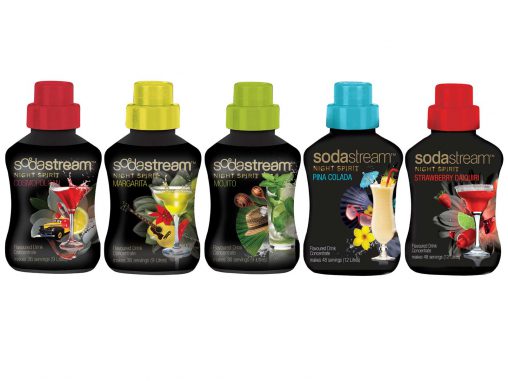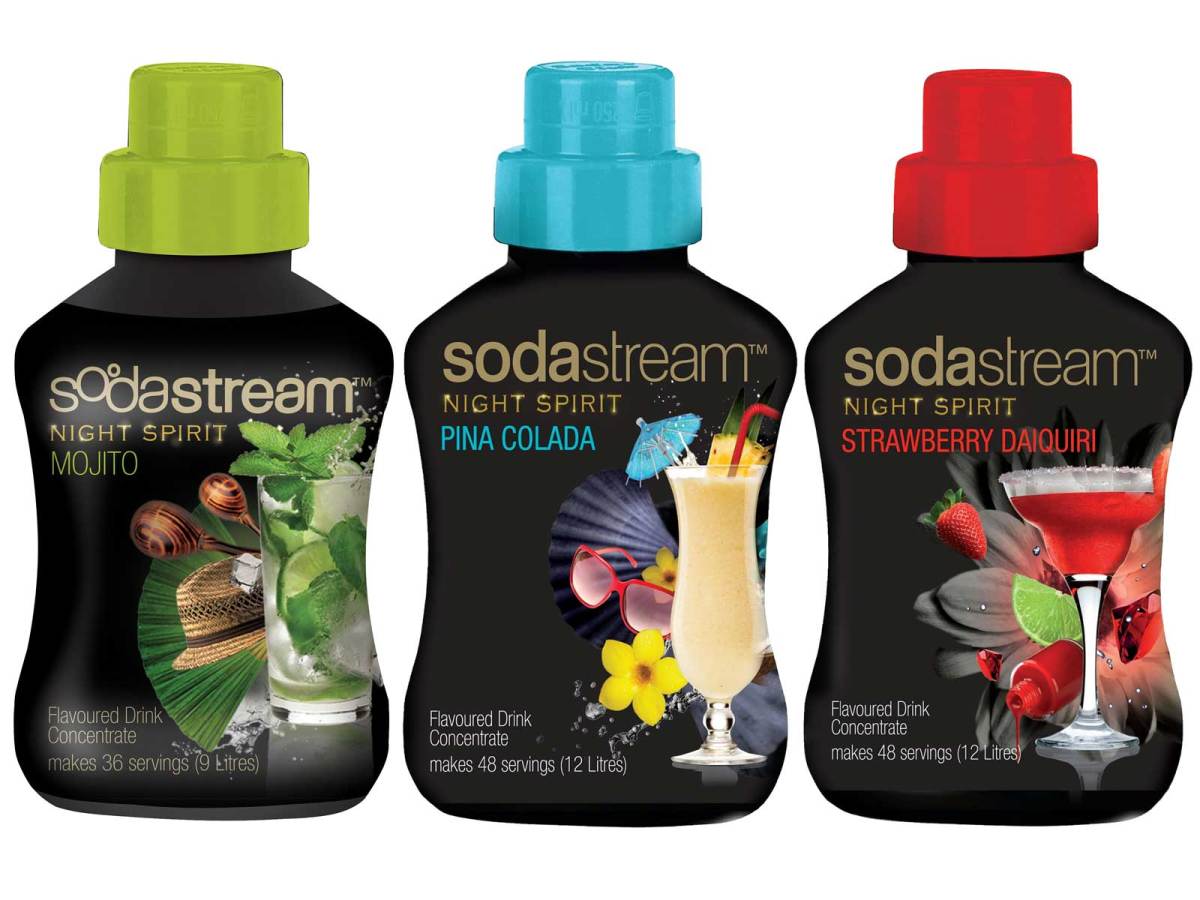This story is a ‘stub’. As the story develops we will add more content to this webpage, so all the information is in one place for our readers. Start from the bottom to read the story in chronological order.
Having tempted us with some hints as to what we would soon see from SodaStream, the local subsidiary of the super-successful 70s throwback has unveiled its new Night Spirits range of pseudo-cocktails.
Although some people will question the point of non-alcoholic piña coladas, mojitos and cosmopolitans (certainly Carries Bradshaw would), it is yet another example of how SodaStream is using interesting and innovative flavours to drive interest in its soft drink system and, most importantly, drive consumers back to the point of purchase.
And, of course, there is nothing stopping you adding a dash of rum, vodka or tequila to make this a proper cocktail…
Simply fizz, flavour and enjoy as either a virgin mocktail or with alcohol for those who like a bang with their bubbles.
Piña Colada brings a taste of Puerto Rico with flavours of sweet pineapple and coconut, whilst Strawberry Daiquiri will remind drinkers of long, lazy holidays in the Caribbean with hints of strawberry and lime. Margarita brings the tangy tastes of lemon and lime together with memories of Mexico, and the Cuban inspired Mojito offers drinkers the unmistakable flavours of mint muddled with fresh lime. Finally, Cosmopolitan adds an air of sophisticated glamour with lime and cranberry flavours.

The Night Spirits range is $6.95 for a 500-millilitre bottle.
Why SodaStream is so hip right now and what to expect in 2014
(Patrick Avenell; 18 October 2013)
In the future, we will all have SodaStream machines. All our soft drinks will be prepared in the home and whenever our carbon dioxide canister or syrup satchels run dry, we will leave them on the front porch for the SodaStream Man to replace overnight, much like the milkman in days of yore.
It sounds fanciful, of course, but that doesn’t stop SodaStream Australia MD Myles Anceschi from dreaming. In a period characterised by low consumer sentiment, price erosion and conditions most often described as “challenging”, SodaStream has stood out as a rare company to show strong growth, even in particularly depressed markets like the United States.
“It’s flying at the moment!” Anceschi says. “There are a couple of key drivers: a strong nostalgic connection with anyone who grew up in the 70s or 80s, new machines and new marketing, better looking machines and a better consumer experience.”
Although the nostalgic aspect cannot be discounted — kids who grew up with SodaStream are now sharing that experience with their own kids — the true driver of this growth has been the machine and syrup innovation.
This impetus for this growth has come from SodaStream’s Israeli parent company reinvesting in the brand and launching a successful cash raising IPO in November 2010. Since launching on the Nasdaq at around $32, the stock price has more than doubled to around $65, while its market capitalisation has grown to almost $1.4 billion.
Not content to settle for the ho-hum, SodaStream has partnered with leading industrial designers to create new machines that emphasise sustainability and aesthetics. The Source machine by Yves Behar was recognised at the 2013 Australian International Design Awards and was also a Red Dot Design Award winner earlier this year.
Within the next six months, SodaStream will also begin rolling out its snap and lock feature to replace the “clunky” screw-in system, as Anceschi puts it, and will also be introducing more design and eco-focused machines.
“We’re really focusing on design — it’s no longer something you have to put away in a cupboard — it’s a much better looking machine it works a lot more efficiently, so the consumer experience is better,” he says.
“There is also an eco-stream of people that don’t want to be throwing PET bottles out and they are engaging with SodaStream because it’s much better for the environment over the long term.”
A major part of the SodaStream story is consumables. There are three separate ongoing sales accompany a machine: the gas cylinders, the syrups and the bottles.
Anceschi is quite up-front when discussing access to these products: he would love to see a system similar to Nespresso’s ‘luxury lifestyle club’, where users can seamlessly purchase consumables online, through mobile apps or in-store.
“We operate sales from our website here in Australia but it’s not ideal — it would be a lot bigger if the platform was less clunky and we had a better user experience — but we do operate that here,” he said, confirming that the 1.5 million syrups and 1 million gas cylinders sold every year are predominantly through the grocery, mass and electrical channels.
“We are working on having a club similar to Nespresso. The challenge for us is delivering the syrups to the consumer in a cost-effective manner but we have got plans afoot and we should have something in place by the end of 2013 or the start of 2014.”
The lack of an omnipresent retail strategy is one of the reasons SodaStream’s popularity lost fizz during the 1990s and 2000s, Anceschi said. A brand like SodaStream has to be everywhere: consumers have to be able to purchase the consumables with minimal effort, at places they already shop, or they will grow fatigued with the system, put the machine away and never use it again.
“Once you get into the habit, it’s relatively easy,” he said. “The biggest barrier has been that we weren’t multichannel and we weren’t omnipresent, so when consumers actively had to seek out supply points, it was a real barrier to enter or to continue to use the system.
“Now we are available across a broad spectrum of electronics stores, mass retailers, supermarkets and department stores, so it relatively easy to find us and it is part of the normal shopping journey.”
Nespresso has also provided another major inspiration for SodaStream: brand partnerships. Nespresso likes to enter a new market by looking at the GfK data, working out who the biggest coffee machine brands are, and then partnering to secure a strong association and sales network.
SodaStream isn’t following this process exactly, though there are degrees of similarity. So far, three partnerships have been announced: Samsung, Breville and KitchenAid.
The first of these co-branded, multifunctional appliances was recently released in Australia, the Samsung Sparkling Fridge, which integrates the SodaStream system into the traditional ice dispenser. This has resulted in an amazing appliance: a premium French Door Fridge that can dispense soda!
“This refrigerator was designed with customers in mind,” said Samsung VP of consumer electronics Phil Newton. “There is significant demand for Samsung refrigerators and for SodaStream’s products, so we merged the two together.”
Although Breville originally pencilled in a 2013 release date for its co-branded appliance, the official response was “we don’t have anything to update you on about the SodaStream/Breville partnership” when we made a follow-up enquiry.
Both SodaStream and Breville are very tightlipped about what the co-branded machine could be, though sources have told us that it is likely to combine Breville functionality with the SodaStream system — for example, Breville’s great heritage in juicing could be integrated with SodaStream to create a sparkling juice dispenser.
The KitchenAid partnership is considered more to do with style than with functionality.
“KitchenAid coming on expands our design cred — they are a beautiful appliance that people love to have on their bench at home,” said Anceschi. “With Breville, you have a well-respected and trusted small appliance manufacturer who is engaging in this whole idea of home carbonation.”
Peter McInnes is the Australian distributor of KitchenAid. We asked senior brand manager Anna Barnes if there was any news on this release.
“As the exclusive distributor of KitchenAid in Australia and New Zealand, we continually review the products made available to us by the USA for distribution,” she said. “However, at this stage, we do not know when or if the products resulting from this collaboration will be available to us and so cannot comment.”
The release of cobranded machines is just one tactic of SodaStream’s 2014 strategy. The company is working on a global syrup platform appropriately titled The World of Flavours; will be replacing the screw lock with the aforementioned snap lock; and will be taking its imitation of Nespresso to even greater levels with the release of Soda Caps, the portioned SodaStream system.
The World of Flavours will make it easier for Australians to access a more diverse range of syrups. Away from the colas and lemonades and orange pop that are broadly famous, SodaStream markets a crazy array of syrups for some acquired palates, including sparkling iced teas, Fountain Mist and Dr Pete.
A partnership with Kraft Foods in the United States has opened up SodaStream to the home carbonation of name-brand drinks like Kool-Aid and Country Time. Anceschi said he would love to do a similar deal with a local drinks brand — he namechecked Cottee’s Cordial — to further stimulate interest in the machines.
Snap locking and Soda Caps could be real game-changers for SodaStream. Users of the current screw and syrup system told us that it can be finicky and applying the syrup can be haphazard; get it wrong and you’re covered in sticky sparkling syrup.
With snap locking, the bottle affixes to the system in one smooth motion, making it much simpler to use, and here is Anceschi explaining Soda Caps:
“Soda Caps is basically like a Nespresso pod: once you’ve made the soda water you just put the Cap onto the top of the bottle, you press it once, it drops the flavour in and you throw the Cap out. This makes the whole ‘flavourisation’ really easy and seamless.”

The SodaStream Source in blue.

